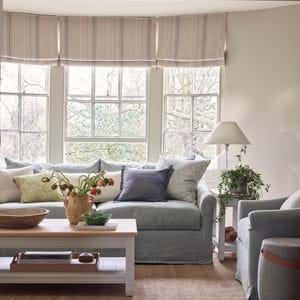Window treatments, part one: choosing what’s right for you
Window treatments, part one: choosing what’s right for you
Wondering where to begin when it comes to choose window treatments? Or perhaps you have a problem window you’re puzzling over? Keep reading for our quick guide.
Curtains versus Roman blinds
The first big question is, are you going to opt for curtains or Roman blinds (we’ll get on to shutters and the like in a minute)? Be led by practicality first and foremost. If you have a radiator underneath your window for instance, you’ll probably want to go for a blind so you don’t block its heat. Likewise if there will be a piece of furniture below it. Blinds also tend to work better in kitchens and bathrooms – curtains can feel a bit impractical, although if they’re well-removed from the cooking and washing areas, they can be a lovely, cosy addition. Curtains are also best for large or full-length windows and for blocking drafts.
Otherwise, the choice is really down to personal preference. Roman blinds have a neater look whereas curtains are more about bringing softness to the room. You can also absolutely choose to combine them, perhaps leaving the curtains just as decoration or drawing both for maximum blackout.
Shutters, etc
We’re not really keen on any other type of blind except Roman. Both Venetian and roller blinds just tend to feel too flimsy or utilitarian and the obvious mechanisms are a distraction. Shutters, however, we do love. If your windows already have their original shutters then lucky you (although you may also want to add curtains for softness). Otherwise, slatted shutters are a great choice for spaces where you want a neater, more minimal look than fabric, where you need something more practical, or where you want greater control over the light and privacy.
‘Problem’ windows
Tall ceiling, short window: where your windows stop well short of your ceiling (in a barn conversion for instance), we’d recommend Roman blinds. Curtains tend to look odd if they’re not mounted close to the ceiling.
Windows of different sizes and shapes: if you have several windows in one room that sit at different heights or are different sizes, we’d suggest that you either use blinds on all of them or, if that doesn’t suit (say with a long window that calls for curtains), then it’s better to use a curtain on one and a blind on the other, rather than curtains on both. The clear contrast will be more appealing than an awkward near-match.
Bay windows: how you treat a bay depends on whether, when the blinds or curtains are shut, you still want to use the bay. If you do, hang blinds or fit your curtains to curve around the bay (this is where we’d recommend a glider pole – more details on that in part two of this journal). Otherwise, curtains in front work fine, although you may also want blinds so you still have the option of using the bay (like at Christmas, when you might place your tree here).
Unusually shaped windows & skylights: if you have a circular window, for instance, then we might even suggest you go without window treatments at all. It would be a shame to lose the architecture the unusual shape brings. The same goes for skylights. If you do need something though, choose custom-made shutters that fit to – rather than distract from – the shape. That said, curtains also work just fine for arched windows.
Doors
Last but not least, let’s touch on doors. Both curtains and Roman blinds are suitable: a Roman blind will sit onto the door itself, and you can use one behind a half-glazed panel for privacy; curtains are a more typical choice and will effectively draught-proof your doorway as well. Just make sure, with curtains, that there’s enough wall space to pull them back out the way. And, with either, it’s lovely to line them with an equally attractive fabric (rather than a plain calico) because you’ll frequently see it as you walk through.













